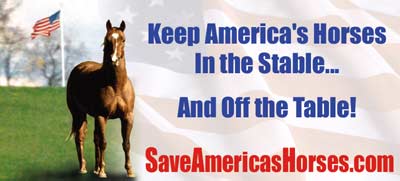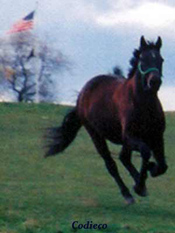
Horse Slaughter
Horse Cruelty
Horse Rescue
Legislation
Stolen Horses
Press
General
SiteMap
Horse Cruelty Info
PA Anti-Cruelty Law
Title 18, Section 5511
Henneke Body Scoring Condition Chart
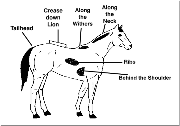 The Henneke Body Scoring Chart is accepted in court as a scientific method of scoring a horse's body condition. It is used successfully in court to prove neglect.
The Henneke Body Scoring Chart is accepted in court as a scientific method of scoring a horse's body condition. It is used successfully in court to prove neglect.
Investigating Cruelty
Successful Enforcement

PA State Police arrest horse dealer at PA horse auction
PA State Police Enforce
PA Anti-Cruelty Law at New Holland, PA Auction
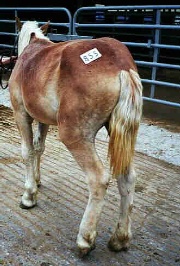
Young draft gelding shipped from NC displays injured left hind leg. A PA equine vet determined that there was no fixing this horse's injured leg. He was humanely euthanised.
No Enforcement
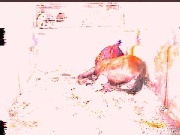
Down and bleeding inside a trailer with Maine license plates at a New Holland, PA auction. Reportedly the horse later died. No charges were ever filed. Blood was pooling on the ground under and outside the trailer.
The Downer Hall of Shame
 Down Belgian was down all day at a PA horse auction. Several bystanders attempted to get the horse to rise. A vet was never called...
Down Belgian was down all day at a PA horse auction. Several bystanders attempted to get the horse to rise. A vet was never called...
The Labor Day Mares
Severely foundered mare's face reveals the pain she is feeling. Mare was found down on a truck at a New Holland auction. Blood oozed from her coronary bands.
A Mule & 2 Standardbreds-
All Had Broken Legs & were Hidden on A Trailer
No Water

Water tank is empty, even though the faucets work..
The Horse the Killers Refused & the vet passed.
Unfit Horses Sold at Auction
PSPCA allows sale - NHPD files charges, owner pleads guilty.
Links
California Voters "Just Say Neigh" to Horse Slaughter!
HoofPAC
Shop online at IGive.com with over 400 great stores you know & love- including Back In the Saddle! Up to 26% of the purchase price is donated to the EPN!
Join today!The EPN gets $5 extra the first time you shop!
PayPal accepts credit cards! Please send your tax deductible donation to the:Equine Protection Network, Inc.,
P. O. Box 232, Friedensburg, PA, 17933.
HoofPAC is the political action committee that has been formed to end the slaughter of America's horses. Cathleen Doyle, founder of HoofPAC, led the successful Save The Horses campaign in 1998 that made the slaughter of California's horses a felony.

Henneke Body Condition Scoring Chart
An Objective Method For Judging A Horse's Body Condition
The Henneke System is an objective evaluation of a horse's body condition. Developed in 1983 by Don R. Henneke, Ph.D., of Tarleton State Texas University, it is based on both visual appraisal and palpable fat cover of the six major points of the horse that are most responsive to changes in body fat.
Don R. Henneke, Ph.D., of Tarleton State Texas University, developed the Henneke Body Scoring Condition Chart in 1983. The original purpose of the system was to determine the fertility of thin mares. It is a scientific method of evaluating a horse's body condition regardless of breed, body type, sex or age. It is now widely used by law enforcement agencies as an objective method of scoring a horse's body condition in horse cruelty cases. The chart is accepted in a court of law.
The chart covers six major parts of the horse; neck; withers, (where the neck ends and the back begins) the shoulder area; ribs, loins, and the tailhead area. The chart rates the horses on a scale of 1 to 9. A score of 1 is considered poor or emaciated with no body fat. A nine is extremely fat or obese. A horse that is rated a 1 on the Henneke Chart is often described as a walking skeleton and is in real danger of dying. Courts in the United States have upheld the seizure of such horses by law enforcement citing exigent circumstances, meaning there was a very strong possibility the horse would die unless immediate action was taken. Horse veterinarians consider a body score of between 4 and 7 as acceptable. A 5 is considered ideal.
Observers are trained to visually inspect the horse and also to palpate each part of the horse with their hands to feel for body fat. The observer then assigns each area of the body the numerical score that corresponds with the horse's condition. When a horse has a long haircoat it is imperative that the person scoring the horse use their hands to feel the horse. The horse's long haircoat will hide the protrusion of bones, all except in the most extreme cases.
The scores from each area are then totaled and divided by 6. The resulting number is the horse's rating on the Henneke Body Scoring Condition Chart.
People working in this field will refer to the horse as being a "1 on the Henneke" or a "3 on the Henneke". The Henneke Chart is a standardized scoring system, whereas the terms, "skinny", "thin", "emaciated", or "fat" are all subjective terms that have different meanings to different people.
Defense attorneys cross examining veterinarians and horse experts argue that the chart is not scientific. As one full time equine vet stated, "No it is not scientific, but it is as close as we are going to get."
The Henneke Body Scoring Condition Chart is readily available. The chart is printed on the back of several manufacturer's of horse feed products and is available on numerous universities web sites. The chart has been used in several leading national horse magazines.

Conformational differences between horses may make certain criteria within each score difficult to apply to every animal. In these instances, those areas influenced by conformation should be discounted, but not ignored when determining the condition score.
Conformation also changes in pregnant mares as they approach parturition (birth). Since the weight of the concept us tends to pull the skin and musculature tighter over the back and ribs, emphasis is placed upon fat deposition behind the shoulder, around the tailhead and along the neck and withers in these cases.
Description of the Condition Score System
Score Description
1 - Poor:
Emaciated. Prominent spinous processes, ribs, tailhead and hooks and pins. Noticeable bone structure on withers, shoulders and neck. No fatty tissues can be palpated.2 - Very Thin:
Emaciated. Slight fat covering over base of spinous processes. Transverse processes of lumbar vertebrae feel rounded. Prominent spinous processes, ribs, tailhead and hooks and pins. Withers, shoulders and neck structures faintly discernible.3 - Thin:
Fat built up about halfway on spinous processes, transverse processes cannot be felt. Slight fat cover over ribs. Spinous processes and ribs easily discernible. Tailhead prominent, but individual vertebrae cannot be visually identified. Hook bones appear rounded, but easily discernible. Pin bones not distinguishable. Withers, shoulders and neck accentuated.4 -Moderately Thin:
Negative crease along back. Faint outline of ribs discernible. Tailhead prominence depends on conformation, fat can be felt around it. Hook bones not discernible. Withers, shoulders and neck not obviously thin.5 - Moderate:
Back is level. Ribs cannot be visually distinguished, but can be easily felt. Fat around tailhead beginning to feel spongy. Withers appear rounded over spinous processes. Shoulders and neck blend smoothly into body.6 - Moderate to Fleshy:
May have slight crease down back. Fat over ribs feels spongy. Fat around tailhead feels soft. Fat beginning to be deposited along the sides of the withers, behind the shoulders and along the sides of the neck.7 - Fleshy:
May have crease down back. Individual ribs can be felt, but noticeable filling between ribs with fat. Fat around tailhead is soft. Fat deposits along withers, behind shoulders and along the neck.8 - Fat:
Crease down back. Difficult to palpate ribs. Fat around tailhead very soft. Area along withers filled with fat. Area behind shoulder filled in flush. Noticeable thickening of neck. Fat deposited along inner buttocks.9- Extremely Fat:
Save America's Horses! |
|||||||
|
Please send your tax deductible donation to: Equine Protection Network, Inc., P. O. Box 232, Friedensburg, PA, 17933 |
||
Save America's Horses- Make the Commitment to Your Horse! |
||
|
Photos On This Page CANNOT be Used Without Written Permission
|
||

